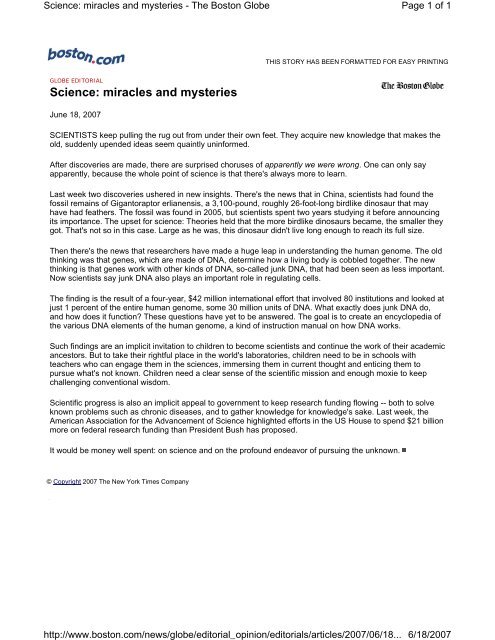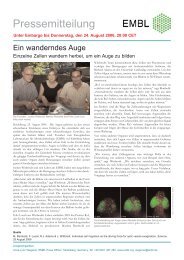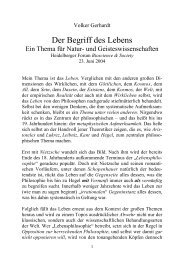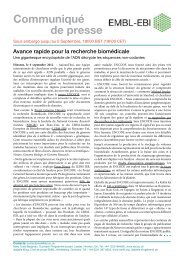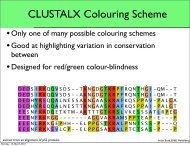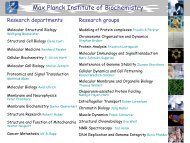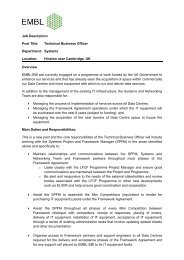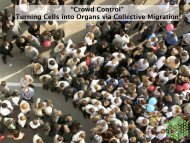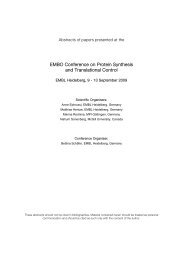Media Clips - EMBL
Media Clips - EMBL
Media Clips - EMBL
Create successful ePaper yourself
Turn your PDF publications into a flip-book with our unique Google optimized e-Paper software.
Science: miracles and mysteries - The Boston Globe<br />
GLOBE EDITORIAL<br />
Science: miracles and mysteries<br />
June 18, 2007<br />
© Copyright 2007 The New York Times Company<br />
THIS STORY HAS BEEN FORMATTED FOR EASY PRINTING<br />
SCIENTISTS keep pulling the rug out from under their own feet. They acquire new knowledge that makes the<br />
old, suddenly upended ideas seem quaintly uninformed.<br />
After discoveries are made, there are surprised choruses of apparently we were wrong. One can only say<br />
apparently, because the whole point of science is that there's always more to learn.<br />
Last week two discoveries ushered in new insights. There's the news that in China, scientists had found the<br />
fossil remains of Gigantoraptor erlianensis, a 3,100-pound, roughly 26-foot-long birdlike dinosaur that may<br />
have had feathers. The fossil was found in 2005, but scientists spent two years studying it before announcing<br />
its importance. The upset for science: Theories held that the more birdlike dinosaurs became, the smaller they<br />
got. That's not so in this case. Large as he was, this dinosaur didn't live long enough to reach its full size.<br />
Then there's the news that researchers have made a huge leap in understanding the human genome. The old<br />
thinking was that genes, which are made of DNA, determine how a living body is cobbled together. The new<br />
thinking is that genes work with other kinds of DNA, so-called junk DNA, that had been seen as less important.<br />
Now scientists say junk DNA also plays an important role in regulating cells.<br />
The finding is the result of a four-year, $42 million international effort that involved 80 institutions and looked at<br />
just 1 percent of the entire human genome, some 30 million units of DNA. What exactly does junk DNA do,<br />
and how does it function? These questions have yet to be answered. The goal is to create an encyclopedia of<br />
the various DNA elements of the human genome, a kind of instruction manual on how DNA works.<br />
Such findings are an implicit invitation to children to become scientists and continue the work of their academic<br />
ancestors. But to take their rightful place in the world's laboratories, children need to be in schools with<br />
teachers who can engage them in the sciences, immersing them in current thought and enticing them to<br />
pursue what's not known. Children need a clear sense of the scientific mission and enough moxie to keep<br />
challenging conventional wisdom.<br />
Scientific progress is also an implicit appeal to government to keep research funding flowing -- both to solve<br />
known problems such as chronic diseases, and to gather knowledge for knowledge's sake. Last week, the<br />
American Association for the Advancement of Science highlighted efforts in the US House to spend $21 billion<br />
more on federal research funding than President Bush has proposed.<br />
It would be money well spent: on science and on the profound endeavor of pursuing the unknown.<br />
http://www.boston.com/news/globe/editorial_opinion/editorials/articles/2007/06/18...<br />
Page 1 of 1<br />
6/18/2007


